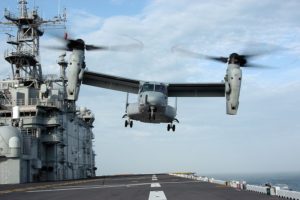The Naval Air Forces Command (NAVAIR) directed all non-deployed Navy aviation units on Monday to conduct a “safety pause” after a series of recent Navy and Marine Corps aircraft crashes.
NAVAIR said the pause is being done “in order to review risk-management practices and conduct training on threat and error-management processes.”
The service said it must ensure safety as one of its top priorities to maintain force readiness.
Deployed units are not necessarily immediately participating but were directed to conduct their version of the safety pause “at the earliest possible opportunity.”
The Navy disclosed at least three aircraft crashes during training flights in June alone.
On June 9, an MH-60S Seahawk helicopter crashed near El Centro, Calif., during a routine training flight, with all four crew surviving and one suffering injuries (Defense Daily, June 10).
Before that, five Marines died in an MV-22B Osprey crash near Glamis, Calif., during another training mission on June 8 (Defense Daily, June 9).

On June 6, a pilot died when a Boeing [BA] F/A-18E Super Hornet crashed near Trona, Calif., during a routine training mission (Defense Daily, June 6).
Also in March an E-2D Advanced Hawkeye aircraft, assigned to Airborne Command and Control Squadron 120 in Norfolk, crashed off the coast of Virginia, killing one crew member and injuring two others.
Previously, last October, a Super Hornet crashed in Death Valley National Park, with the pilot surviving (Defense Daily, Oct. 8, 2021).
Sen. James Inhofe (R-Okla.) on Monday said on Twitter that given these accidents the Defense Department “needs to prioritize implementing the recommendations of the National Commission on Military Aviation Safety. Congress can do its part by providing adequate, on-time funding.”
Given the string of aviation accidents in recent months, the @DeptofDefense needs to prioritize implementing the recommendations of the National Commission on Military Aviation Safety. Congress can do its part by providing adequate, on-time funding. https://t.co/fYDiiqbUOt
— Sen. Jim Inhofe (@JimInhofe) June 13, 2022
The fiscal year 2019 defense authorization act created the commission and it released a report in December 2020. The commission recommended the creation of a Joint Safety Council to advise the deputy secretary of defense on safety issues (Defense Daily, Dec. 3, 2020).
Such a council would be led by safety officials from all the military services, establish military aviation safety standards, collect and analyze safety data and develop priorities.
According to the final report, more than 6,000 military aviation mishaps between 2013 and 2018 caused 198 deaths and more than $9.41 billion in damages with 157 destroyed aircraft.
While DoD officials concurred with the recommendations, the council has still not been established.